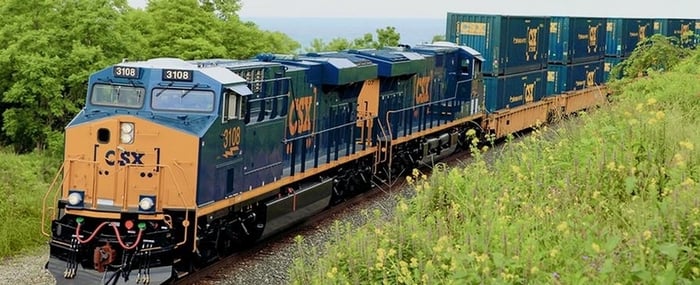CSX Corporation (CSX -0.14%) surprised investors with extremely healthy results on its release of first-quarter 2018 earnings Tuesday after the markets closed. While lower volumes compressed the company's top line, leading to essentially flat revenue of $2.9 billion, net income soared 92%, to $695 million, due to cost-cutting and the fruit of productivity initiatives. Shares responded in kind, as CSX stock gained nearly 8% in Wednesday's trading session.
Below, I'll review three key takeaways for investors derived from the impressive report and management's accompanying earnings conference call.

Image source: Getty Images.
Operational efficiency is climbing
CSX improved its operating ratio tremendously in the first quarter of 2018. This ratio, found by dividing total operating expenses by revenue, is used extensively in the railroad industry to measure operational progress. A lower operating ratio denotes a higher degree of efficiency.
In the first three months of the year, CSX achieved an adjusted operating ratio of 63.7%, a reduction of 570 basis points over the prior-year's ratio of 69.4%, marking a first-quarter record.
A portion of this improvement can be traced to CEO Jim Foote's decision to continue the process of converting CSX to a scheduled railroad, a project former CEO Hunter Harrison set into motion before passing away unexpectedly in December 2017. A scheduled railroad is one that optimizes rail assets while focusing on creating and maintaining an extremely strict service plan.
The success of this initiative is evident in several metrics that suggest higher productivity. CSX's average train velocity reached 17.3 mph in the first quarter of 2018 versus 14.2 mph a year ago. Average train length expanded to 6,886 feet against 6,560 feet in the first quarter of 2017. And terminal car dwell time was reduced to 10.4 hours in the most recent quarter from an average 11.5 hours in the prior-year quarter.
Cost-cutting measures have also contributed to the lower operating ratio. A headcount reduction of 11% produced a 12% decrease in labor costs in the first quarter. The company is also saving on costs by keeping 800 locomotives and over 20,000 rail cars in storage, while utilizing eight fewer hump yards (i.e. elevated yards that use the force of gravity to sort rail cars).
CSX's sharp year-over-year change in operating ratio is a clear signal to investors that despite volume pressures, the company is in control of its bottom line and can boost earnings per share even in a flat revenue environment.
Expect aggressive share repurchases
In late February, CSX issued $2 billion in long-term debt obligations, with interest rates ranging from 3.8% to 4.65%. In its first-quarter earnings report, the company described the uses of these funds as follows: "The net proceeds will be used for general corporate purposes, which may include repurchases of CSX's common stock, capital investment, working capital requirements, improvement in productivity and other cost reductions at CSX's major transportation units."
Repurchasing CSX's common stock may turn out to be the biggest utilization of this cash. Since the debt issuance, the company has already used $836 million for share repurchases that were conducted in the last weeks of the quarter. Shareholders should see continued buybacks at a heady pace during the following quarters as the company increased its previous $1.5 billion share-repurchase authorization to $5 billion in February. Management expects the revised repurchase program to be completed by the first quarter of 2019.

Image source: CSX Corporation.
Not capitalizing on trucking woes -- yet
If you follow consumer-goods companies that rely on freight shipments, you've probably heard management teams complain about higher truck shipment costs. Several factors have negatively impacted the trucking industry over the last few quarters. A shortage of skilled drivers, higher fuel expense, and a moderately expanding economy have tightened trucking capacity while making road freight more expensive.
During CSX's earnings conference call, management was asked several times by analysts if there was an opportunity for CSX to take advantage of trucking-sector weakness, particularly via its intermodal business.
CEO Foote presented many reasons why the company isn't jumping to take some transportation market share from trucking -- at least in the immediate future. First, since volumes are low and pricing power for railroads is a bit weak at the moment, it doesn't make sense to offer discounts as a lower-cost alternative to trucking. This makes sense when you consider that any additional business from trucking is likely to be a cyclical opportunity.
Further, as I suggested above, the scheduled railroad model relies on a strictly controlled capacity environment. It doesn't allow for a great deal of improvisation or provide the flexibility for CSX to begin tactically chasing a temporary revenue stream. However, Foote didn't rule out the possibility of gradually obtaining market share from the road industry if conditions continue to persist.
For now, shareholders should enjoy the returns being generated by the discipline of the scheduled railroad model. Interestingly, that model posits that margins improve when a railroad errs on the side of ignoring incremental revenue opportunities and instead focuses on core business -- and core customers.





